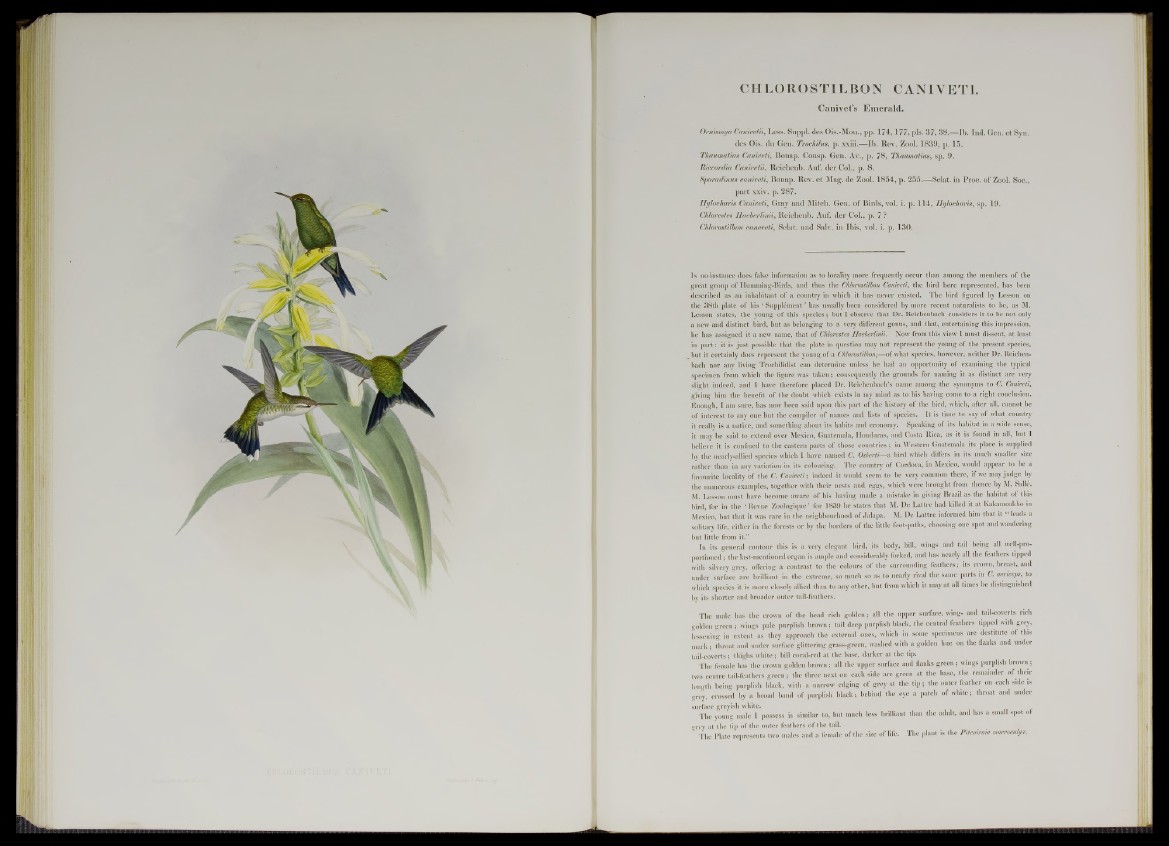
CHLOROSTILBON CANIYETL
Canivet’s Emerald.
Ornismya Canivetii, Less. Suppl. des Ois.-Mou., pp. 1 7 4 ,1 7 7 , pis. 3 7 ,3 8 .— lb . Ind. Gen. e t Syn.
des Ois. du Gen. TrocMlm, p. xxiii.—lb . Rev. Zool. 1839, p. 15.
Thaumatias Caniveti, Bonap. Consp. Gen. Av., p. 78, Thaumatias, sp. 9.
Riccordia Canivetii, Reiehenb. Auf. der Col., p. 8.
Sporadinus caniveti, Bonap. Rev. e t Mag. de Zool. 1854, p. 255.— Sclat. in Proc. of Zool. Soc.,
p a rt xxiv. p. 287.
Hylocharis Caniveti, Gray and Mitch. Gen. o f Birds, vol. i. p. 114, Hylocliaris, sp. 19.
Chlorestes JIaeberlinii, Reiehenb. Auf. der Col., p. 7 ?
Chloro8tilbon caneveti, Sclat. and Salv. in Ibis, vol^if p. 130.
I n no instance does false information as to locality more frequently occur than among the members of the
great group of Humming-Birds, and thus the Cllorostilbon Caniveti, the bird here represented, has been
described as an inhabitant of a country in which it has never existed. The bird figured by Lesson on
the 38th plate of his ‘ Supplement ’ has usually been considered by more recent naturalists to be, as M.
Lesson states, the young of this species; but I observe that Dr. Reichenbach considers it to be not only
a new and distinct bird, but as belonging to a very different genus, and that, entertaining this impression,
he has assigned it a new name, that of Chlorestes Haeberlinii. Now from this view I must dissent, at least
in p a rt: it is just possible that the plate in question may not represent the young of the present species,
but it certainly does represent the young of a Cklorostilbon,—of what species, however, neither Dr. Reichenbach
nor any living Trochilidist can determine unless he had an opportunity of examining the typical
specimen from which the figure was taken; consequently the grounds for naming it as distinct are very
slight indeed, and I have therefore placed Dr. Reichenbach’s name among the synonyms to C. Caniveti,
giving him the benefit of the doubt which exists in my mind as to his having come to a right conclusion.
Enough, I am sure, has now been said upon this part of the history of the bird, which, after all, cannot be
of interest to any one but the compiler of names and lists of species. It is time to say of what country
it really is a native, and something about its habits and economy. Speaking of its habitat in a wide sense,
it may be said to extend over Mexico, Guatemala, Honduras, and Costa Rica, as it is found in all, but I
believe it is confined to the eastern parts of those countries; in Western Guatemala its place is supplied
by the nearly-allied species which I have named C. Osberti—a bird which differs in its much smaller size
rather than in any variation in its colouring. The country of Cordova, in Mexico, would appear to be a
favourite locality of the C. Caniveti; indeed it would seem to be very common there, if we may judge by
the numerous examples, together with their nests and eggs, which were brought from thence by M. Salle.
M. Lesson must have become aware of his having made a mistake in giving Brazil as the habitat of this
bird, for in the ‘ Revue Zoologique ’ for 1839 he states that M. De Lattre had killed it at Kakamoakho in
Mexico, but that it was rare in the neighbourhood of Jalapa. M. De Lattre informed him that it “ leads a
solitary life, either in the forests or by the borders of the little foot-paths, choosing one spot and wandering
but little from it.”
In its general contour this is a very elegant bird, its body, bill, wings and tail being all well-proportioned
; the last-mentioned organ is ample and considerably forked, and has nearly all the feathers tipped
with silvery grey, offering a contrast to the colours of the surrounding feathers; its crown, breast, and
under surface are brilliant in the extreme, so much so as to nearly rival the same parts in C. auriceps, to
which species it is more closely allied than to any other, but from which it may at all times be distinguished
hy its shorter and broader outer tail-feathers.
The male has the crown of the head rich golden; all the upper surface, wing- and tail-coverts rich
golden green; wings pale purplish brown; tail deep purplish black, the central feathers tipped with grey,
lessening in extent as they approach the external ones, which in some specimens are destitute of this
mark ; throat and under surface glittering grass-green, washed with a golden hue on the flanks and under
tail-coverts; thighs white; bill coral-red at the base, darker at the tip.
The female has the crown golden brown; all the upper surface and flanks green; wings purplish brown;
two centre tail-feathers green; the three next on each side are green at the base, the remainder of their
length being purplish black, with a narrow edging of grey at the tip; the outer feather on each side is
grey, crossed by a broad band of purplish black; behind the eye a patch of white; throat and under
surface greyish white.
The young male I possess is similar to, but much less brilliant than the adult, and has a small spot ot
grey at the tip of the outer feathers of the tail.
The Plate represents two uuilcs anti a female of the size of life. The plant is the PUcaimia macrocalyx.